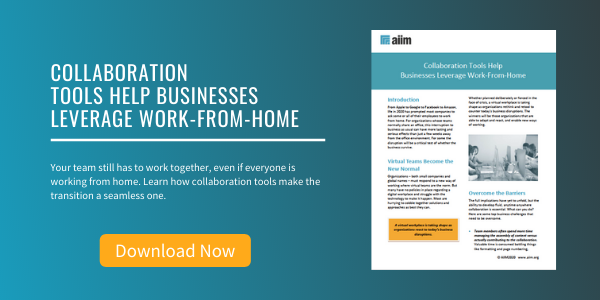
What Are the Top Approaches to Collaborative Work?
Team collaboration is one of the biggest factors that will contribute to the success of any business in the next decade. A joint study between the Institute for Corporate Productivity and Babson College found that companies that actively work to leverage collaboration as an organizational skill are five times more likely to be high performing. And after studying 55 of the largest teams from companies like the BBC, Marriott, and Pixar, researchers identified that the top factor in peak performance was the fact that leaders of the organization championed and enabled collaboration as an operational imperative. This means establishing the ability to collaborate on content at any point in its lifecycle securely.
Many of the core activities related to the lifecycle of enterprise content are collaborative by nature. Creating, revising, and reviewing content are tasks that often involve two or more people.
Content that has been drafted, saved into an information management system, and organized with metadata often will still require revision cycles, proofreading, and approvals before it is considered complete. Information management systems can provide an efficient, solid foundation for such content sharing, co‐creation or review activities.
There are significant challenges in ensuring access to the content and governance over that content, so that users can access the content they need without hassle, while at the same time ensuring they don’t have access to things they shouldn’t.
Three Approaches to Collaborative Work
There are three approaches to collaborative work. Different information management solutions may offer tools that have strong capabilities in some or all of these approaches.
-
Person-to-Person Collaboration
Collaboration may be person‐to‐person. Peers working for a clear common purpose can use collaboration tools to exchange content, gather knowledge from each other, see new approaches and create an opportunity for shared wisdom to emerge.
Techniques can be synchronous – meaning interactive, real‐time communication is supported. Synchronous tools may be streaming activity updates, electronic whiteboarding, chat windows, online voice or video discussions.
Asynchronous collaboration means information sharing happens with a more broadcast model: users receive and consume content when they choose. Examples of asynchronous collaboration could be email, starting a discussion forum thread, or publishing a blog post. This is the type of collaboration that is most familiar to most users.
-
Context-Driven Collaboration
Collaboration activities may be context‐driven. Content that is well‐defined with metadata and organized with consistent tags or descriptors can be automatically surfaced, presented, or recommended by the underlying search or analytic engines that are part of information management systems.
Content could be aggregated or syndicated into virtual dashboards or workspaces along with similar content from other line of business systems, or external web sites. The term “mash‐up” can also be used for this aggregation of related but separate content types. New perspectives or insights into information can be revealed when content is combined in unique ways.
-
Process-Driven Collaboration
Collaboration can also be driven by processes. Workflows are often structured forms of collaborative activity, with software managing the stages and tasks particular users or groups need to perform to achieve a common purpose. Transactional business, or content that requires formalized approval and sign‐off, is well‐suited to structured or process‐driven collaboration.
The Collaboration Imperative
Superior collaboration has become a business imperative. The need for team members and colleagues to not only work together but to ‘think’ together on issues of critical concern has increased. This has resulted in shifting the emphasis from individual efforts to group work, from independence to community, and from information silos to open data and collaboration. A highly effective and productive workplace needs to be more than just a sum of its parts, and intelligent information management helps bring the pieces together.
About Kevin Craine
Kevin Craine is a professional writer, an internationally respected technology analyst, and an award-winning podcast producer. He was named the #1 Enterprise Content Management Influencer to follow on Twitter and has listeners and readers worldwide. Kevin creates strategic content for the web, marketing, social media, and more. He is the written voice for some of North America's leading brands and his interviews feature today's best thought leaders. His client list includes many well-known global leaders like IBM, Microsoft and Intel, along with a long list of individuals and start-ups from a wide variety of industries. Kevin's podcasts have been heard around the world, including the award-winning weekly business show "Everyday MBA". He is also the host and producer of "Bizcast" on C-Suite Radio and the producer behind podcasts for Epson, Canon, IBM and AIIM International, among others. Prior to starting Craine Communications Group, Kevin was Director of Document Services for Regence BlueCross BlueShield where he managed high volume document processing operations in Seattle, Portland and Salt Lake City. He also spent time at IKON as an Enterprise Content Management consultant working with national and major accounts. He was the founding editor of Document Strategy magazine. Kevin has also been, at one point or another, an adjunct university professor, a black belt martial artist, and a professional guitarist. Kevin holds an MBA in the Management of Science and Technology as well as a BA in Communications and Marketing.



